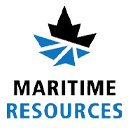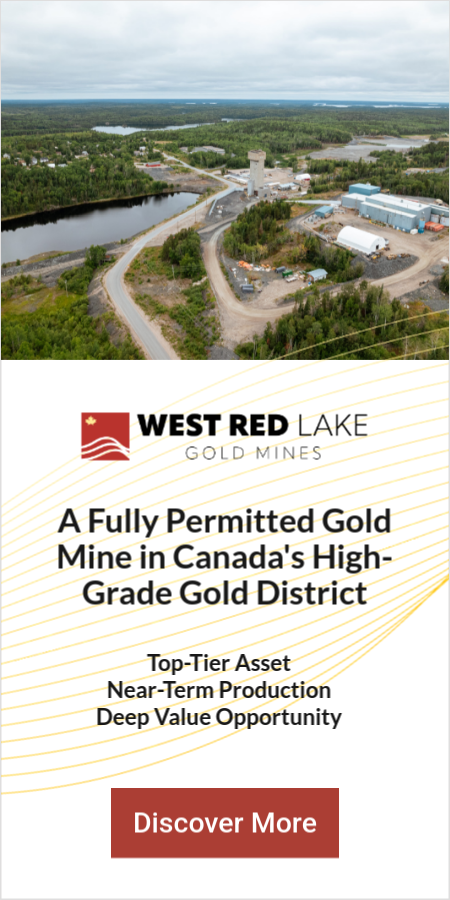Maritime Securityholders Approve NFG Arrangement & Accelerate the Path to a Tier-1 Canadian Gold Producer

Maritime shareholders approve New Found Gold acquisition with 99.68% support. Transaction adds near-term cash flow, permitted infrastructure, self-funding strategy.
- Maritime Resources shareholders approved New Found Gold's acquisition with 99.68% support, materially de-risking the transaction and positioning the company for near-term cash flow upon closing expected around November 13, 2025.
- Upon completion, the combination will provide access to permitted infrastructure, a high-grade open-pit reserve base, and the ability to self-fund key portions of Queensway Phase 1 capital.
- Strengthened management, including the appointment of General Counsel Jelena Novikov Fried, enhances execution capability through permitting, development, and M&A integration.
- Queensway's strong economics (NPV5% C$743M at US$2,500/oz Au, IRR 56.3%, AISC US$1,256/oz) position it as a district-scale growth asset in a constrained North American gold development pipeline.
- With district-scale exploration results, a tightening gold macro backdrop, and near-term development catalysts, New Found Gold approaches a decisive re-rating window for institutional investors.
Why This M&A Approval Matters Now
North American gold development faces structural constraints that have fundamentally altered valuation dynamics across the sector. The pipeline of large, low-AISC projects continues to narrow as reserve grades decline globally, discovery rates slow, and permitting timelines extend. Institutional capital increasingly concentrates on developers demonstrating clear paths to near-term cash flow combined with scalable exploration growth, a combination that has become rare in the current market environment.
New Found Gold's (TSX-V: NFG) recently approved acquisition of Maritime Resources represents a strategic response to these sector dynamics. The transaction addresses multiple development bottlenecks: securing permitted processing infrastructure, accessing high-grade reserves capable of generating immediate cash flow, and establishing a production platform that can self-fund expansion into one of North America's highest-grade undeveloped gold districts.
The overwhelming shareholder approval, 99.68% of Maritime shareholders voting in favor on November 5, 2025, removes a significant execution risk and materially improves visibility on 2026 cash flow commencement. Maritime is scheduled to seek final court approval on November 7, 2025, with closing expected on or around November 13, 2025, subject to satisfaction of remaining customary closing conditions. Chief Executive Officer Keith Boyle frames the strategic transition:
"We transition from the world of exploration into the world of production… We have a clear line of sight now with this production added to Queensway."
Tightening Gold Supply & North American Production Challenges
Global gold reserve grades have declined substantially over recent decades, while capital intensity for new mine development has increased significantly. North American producers face particular challenges: aging infrastructure, rising labor costs, and permitting windows that frequently extend beyond five years. The combination has created a supply deficit in high-grade, low-cost development projects, particularly those advancing toward production within a three-year timeframe.
Institutional investors have responded by applying premium valuations to companies demonstrating execution momentum. Developers with clear paths to low-cost production, strong jurisdictional credentials, and visible catalyst pipelines command higher enterprise value per ounce multiples than peers reliant on greenfield development or third-party infrastructure.
Capital Markets Trend: Developers with Infrastructure Outperform
Companies entering production with existing mills and processing facilities consistently trade at premium enterprise value to net asset value multiples compared to peers requiring new infrastructure construction. The valuation advantage stems from reduced capital requirements, compressed development timelines, lower permitting risk, and earlier cash flow generation that reduces equity dilution.
New Found Gold's acquisition of the Pine Cove Mill and Nugget Pond Gold Plant through the Maritime transaction directly addresses this infrastructure advantage. Pine Cove is currently processing ore from Maritime's Hammerdown mine and is fully permitted with an established tailings facility. Nugget Pond is a 700-tonne-per-day hydrometallurgical gold circuit that previously processed Hammerdown ore with 95% recovery rates. Together, these facilities are expected to eliminate major capital requirements that would otherwise extend Queensway's development timeline. Chief Executive Officer Keith Boyle emphasizes:
"In our Queensway preliminary economic assessment, we had assumed toll milling at a third-party mill. Being able to secure a facility where we could send that Phase 1 ore really does de-risk the project."
The 99.68% Maritime Securityholder Approval: What It Signals for Investors
Maritime Resources shareholders voted overwhelmingly in favor of the arrangement agreement with New Found Gold, with 99.68% approval representing one of the highest support levels recorded for Canadian mining transactions in recent years. This extraordinary alignment reflects stakeholder confidence in New Found Gold's ability to execute an aggressive development plan and create value through operational integration.
High approval percentages materially reduce integration and legal risk during the post-closing period. They indicate management credibility with acquired company shareholders, alignment on strategic direction, and reduced probability of dissenting shareholder challenges or legal complications that can derail merger timelines.
Closing Timeline & Strategic Outcome
Maritime Resources shareholders approved the transaction on November 5, 2025. Maritime is scheduled to seek final court approval on November 7, 2025, with closing expected on or around November 13, 2025. Upon completion, the combination will create an emerging Canadian gold producer with complementary asset characteristics. Hammerdown will transition into New Found Gold's near-term cash flow engine, designed specifically to fund portions of Queensway Phase 1 capital requirements of approximately C$155 million. Chief Executive Officer Keith Boyle articulates the funding strategy:
"We saw the cash flow from Hammerdown as a piece of the financing for our Queensway Phase 1… Having that cash flow means we now have a much greater number of alternatives for financing, and we'll be able to finance the project quite easily."
Strengthening the Management Bench: Execution as a Value Catalyst
New Found Gold appointed Jelena Novikov Fried as General Counsel and Corporate Secretary effective November 3, 2025, strengthening governance capabilities during a complex operational transition period. Novikov Fried brings over 20 years of experience in corporate, commercial, governance, and securities compliance.
Her track record includes serving as Legal Director, Corporate and Securities at Li-Cycle Holdings Corporation, where she played a key role in compliance initiatives and contributed to the successful sale of the company. This experience directly translates to New Found Gold's current requirements: managing M&A integration, navigating permitting processes, and ensuring governance standards meet institutional investor expectations during the transition from explorer to producer.
The Combined Asset Base: From Exploration Story to Emerging Producer
The Queensway Project encompasses over 175,000 hectares across a 110-kilometer strike length in north-central Newfoundland. The project's geological setting features high-grade, near-surface mineralization hosted in a structural corridor along two major fault structures.
Queensway's mineral resource estimate (effective date March 15, 2025) demonstrates exceptional grades: 18 million tonnes indicated at 2.40 grams per tonne gold (g/t Au) containing 1.39 million ounces, and 10.7 million tonnes inferred at 1.77 g/t Au containing 610 thousand ounces. The 2025 exploration program has completed approximately 52,000 meters of diamond drilling year-to-date against a planned 70,000 meters, representing 75% program completion. Step-out drilling continues to intersect mineralization beyond the current mineral resource estimate boundary.
Hammerdown: Fully Permitted, High-Grade & Immediately Relevant
The Hammerdown Gold Project holds proven and probable reserves of 1.9 million tonnes grading 4.46 g/t Au (272 thousand ounces) based on the 2022 Feasibility Study. The project's open-pit configuration minimizes capital requirements and operating complexity, while its fully permitted status enables near-term production commencement.
Hammerdown is targeted to ramp up to full production in early 2026. The mine and mill are fully permitted, with initial production currently in progress. Development encompasses approximately $15 million to $20 million in capital costs for mine site earthworks, pre-stripping, crushing infrastructure, and mill upgrades. Ore processing commenced at the Pine Cove Mill in the fall of 2025, with the operation currently producing.
Infrastructure Advantage: Pine Cove Mill & Nugget Pond Plant
Pine Cove is currently processing Hammerdown ore under a fully permitted operational framework with an established tailings facility. Nugget Pond provides a 700-tonne-per-day hydrometallurgical gold circuit that previously achieved 95% recovery rates, though the facility is currently idle.
Constructing comparable processing facilities typically requires $50 million to $150 million in capital expenditure and extends project timelines by 18 to 36 months. New Found Gold's acquisition of existing, permitted facilities removes this entire development pathway, accelerating Queensway's timeline to production and reducing execution risk. Management expects to determine the best approach for sending Queensway ore to the processing facilities by year-end 2025 or first quarter 2026.
New Found Gold's acquisition of existing, permitted facilities removes this entire development pathway, accelerating Queensway's timeline to production and reducing execution risk. Management expects to determine the best approach for sending Queensway ore to the processing facilities by year-end 2025 or first quarter 2026. Keith Boyle highlights:
“What we're doing now is looking at the best approach uh to send the Queensway ore over to the mill. We're looking at making that decision probably by year end if not in the first quarter and submitting our permit application with that in mind.”
Economics & Development Path: Understanding the Value Drivers
Queensway's preliminary economic assessment released July 21, 2025, establishes an all-in sustaining cost (AISC) of US$1,256 per ounce over the life of mine at US$2,500 per ounce gold. AISC represents the total cash cost required to produce and sell one ounce of gold, including mining, processing, general and administrative expenses, sustaining capital, and reclamation costs.
The project generates an after-tax net present value (NPV) of C$743 million using a 5% discount rate, with an internal rate of return (IRR) of 56.3% and after-tax payback period under two years. NPV represents the present value of future cash flows discounted to current dollars, while IRR measures the project's effective annual return rate.
Leverage to Higher Gold Prices
At US$3,300 per ounce gold, the project's IRR increases to 197%, while NPV expands by C$1.45 billion relative to the base case. This price sensitivity creates substantial leverage during gold bull markets, providing investors with asymmetric upside exposure while maintaining economic viability at lower gold prices.
Funding Strategy: Hammerdown as a Self-Funding Platform
Hammerdown's projected cash flow is expected to contribute directly to Queensway Phase 1 capital requirements. The self-funding mechanism is designed to reduce reliance on equity financing during construction, limiting shareholder dilution. Companies entering construction with committed cash flow access more favorable debt terms, lower interest rates, and reduced covenant restrictions compared to peers reliant entirely on external capital.
Jurisdictional Advantage: Why Newfoundland Matters for Valuation
Newfoundland operates within Canada's federal and provincial regulatory framework, which has historically provided stable permitting processes, predictable environmental standards, and established labor markets. This jurisdictional stability contrasts with gold-producing regions facing resource nationalism, expropriation risk, or fiscal instability—factors that consistently depress valuations for otherwise comparable assets.
Canadian mining jurisdictions have historically maintained transparent permitting timelines and enforceable contract law that reduce sovereign risk for international investors. These characteristics translate directly into valuation premiums, with Canadian developers typically trading at higher enterprise value per ounce multiples compared to peers operating in higher-risk jurisdictions.
Logistics & Infrastructure Positioning
Queensway sits approximately 15 kilometers from Gander with access from the Trans-Canada Highway, providing road access to processing facilities, supply chains, and labor markets. The project's proximity to existing transmission lines, with proposed transmission line routes identified near the site, is expected to provide grid power access that would eliminate the need for diesel generation. Proximity to established communities provides access to skilled labor without requiring extensive fly-in, fly-out operations that increase costs and complicate workforce management.
Valuation Considerations for Investors
Gold developers typically trade on enterprise value per ounce (EV/oz) and enterprise value to net present value (EV/NPV) multiples, with significant variation based on development stage, jurisdiction, management track record, and project economics. High-grade developers in Tier-1 jurisdictions advancing toward near-term production consistently command premium multiples.
Multiple catalysts could drive valuation re-rating over the next 12 to 24 months. Improved cash flow visibility as Hammerdown ramps to production provides concrete financial metrics that reduce investor uncertainty. Updated resource estimates following ongoing drilling programs expand the asset base and potential mine life. Progress toward Queensway's production decision, particularly successful permitting milestones, reduces execution risk and supports higher valuation multiples.
The Investment Thesis for New Found Gold
- Near-term cash flow from permitted, high-grade assets helps self-fund development and reduces dilution risk during the construction phase when external financing typically creates significant shareholder value transfer.
- District-scale exploration upside offers long-term leverage to gold prices and potential for multi-phase mine life extensions that compound value creation beyond initial production scenarios.
- High-grade, low-cost production profiles support margin resilience through commodity price cycles while creating asymmetric upside exposure during gold bull markets.
- Infrastructure ownership accelerates development timelines and improves project economics versus peers requiring third-party processing arrangements or new mill construction.
- Strengthened management teams with relevant development and operational experience increase execution confidence for permitting processes, financing arrangements, and construction delivery.
- Jurisdictional positioning in Newfoundland provides permitting predictability and regulatory stability compared with developers operating in regions facing resource nationalism, fiscal instability, or permitting uncertainty.
- Clear catalyst pipelines support improved visibility on technical de-risking and re-rating opportunities through exploration success, permitting progress, and production commencement.
What This Means for Investors
Maritime Resources' overwhelming shareholder approval—99.68% voting in favor, materially advances New Found Gold's transition from high-grade explorer toward emerging Canadian gold producer. The approval removes a significant execution overhang while establishing a production platform designed to self-fund Queensway's Phase 1 development, reducing the dilution risk that typically accompanies pre-production financing.
Strengthened management capacity through the General Counsel appointment and planned Maritime team retention, combined with near-term production visibility from Hammerdown and district-scale exploration upside at Queensway, elevates New Found Gold's strategic profile within the North American gold development sector. The infrastructure advantages secured through the Pine Cove Mill and Nugget Pond facilities are expected to eliminate major capital requirements and permitting dependencies that burden competing developers.
This transaction repositions New Found Gold into the category of development-stage companies with credible near-term re-rating potential upon transaction closing expected around November 13, 2025. The combination of Tier-1 jurisdictional positioning, strong project economics, and clear catalyst visibility creates a differentiated investment proposition as the company advances toward production while maintaining district-scale exploration optionality across the Queensway system.
TL;DR
Maritime Resources shareholders overwhelmingly approved New Found Gold's acquisition with 99.68% support on November 5, 2025, with closing expected around November 13, 2025. The transaction provides New Found Gold with immediate access to the fully permitted, high-grade Hammerdown mine targeting production in early 2026, plus the operating Pine Cove Mill and idle Nugget Pond processing facilities. This infrastructure eliminates major capital requirements for Queensway development. Hammerdown's projected cash flow is designed to self-fund portions of Queensway's C$155 million Phase 1 capital, reducing equity dilution. Combined with Queensway's strong economics (NPV C$743M, IRR 56.3%, AISC US$1,256/oz) and district-scale exploration upside across 175,000 hectares, the transaction positions New Found Gold as an emerging Canadian producer with near-term re-rating catalysts.
FAQs (AI-Generated)
Analyst's Notes




Subscribe to Our Channel
Stay Informed




































